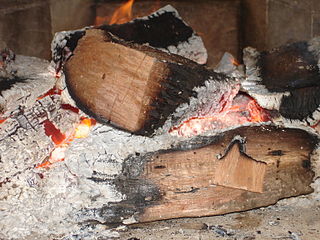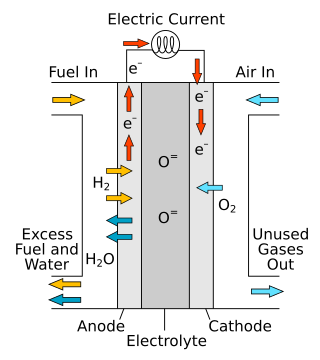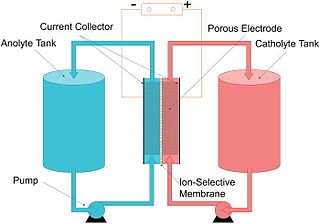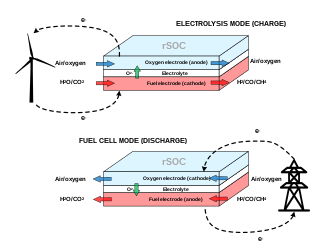Related Research Articles

A fuel cell is an electrochemical cell that converts the chemical energy of a fuel and an oxidizing agent into electricity through a pair of redox reactions. Fuel cells are different from most batteries in requiring a continuous source of fuel and oxygen to sustain the chemical reaction, whereas in a battery the chemical energy usually comes from substances that are already present in the battery. Fuel cells can produce electricity continuously for as long as fuel and oxygen are supplied.

In chemistry and manufacturing, electrolysis is a technique that uses direct electric current (DC) to drive an otherwise non-spontaneous chemical reaction. Electrolysis is commercially important as a stage in the separation of elements from naturally occurring sources such as ores using an electrolytic cell. The voltage that is needed for electrolysis to occur is called the decomposition potential. The word "lysis" means to separate or break, so in terms, electrolysis would mean "breakdown via electricity".

The triboelectric effect describes electric charge transfer between two objects when they contact or slide against each other. It can occur with different materials, such as the sole of a shoe on a carpet, or between two pieces of the same material. It is ubiquitous, and occurs with differing amounts of charge transfer (tribocharge) for all solid materials. There is evidence that tribocharging can occur between combinations of solids, liquids and gases, for instance liquid flowing in a solid tube or an aircraft flying through air.
Surface science is the study of physical and chemical phenomena that occur at the interface of two phases, including solid–liquid interfaces, solid–gas interfaces, solid–vacuum interfaces, and liquid–gas interfaces. It includes the fields of surface chemistry and surface physics. Some related practical applications are classed as surface engineering. The science encompasses concepts such as heterogeneous catalysis, semiconductor device fabrication, fuel cells, self-assembled monolayers, and adhesives. Surface science is closely related to interface and colloid science. Interfacial chemistry and physics are common subjects for both. The methods are different. In addition, interface and colloid science studies macroscopic phenomena that occur in heterogeneous systems due to peculiarities of interfaces.

In molecular physics and chemistry, the van der Waals force is a distance-dependent interaction between atoms or molecules. Unlike ionic or covalent bonds, these attractions do not result from a chemical electronic bond; they are comparatively weak and therefore more susceptible to disturbance. The van der Waals force quickly vanishes at longer distances between interacting molecules.

The pyrolysis process is the thermal decomposition of materials at elevated temperatures, often in an inert atmosphere.

Adhesion is the tendency of dissimilar particles or surfaces to cling to one another.

Sir Arnold Whittaker Wolfendale FRS was a British astronomer who served as the fourteenth Astronomer Royal from 1991 to 1995. He was Professor of Physics at Durham University from 1965 until 1992 and served as president of the European Physical Society (1999–2001). He was President of the Royal Astronomical Society from 1981 to 1983.
A regenerative fuel cell or reverse fuel cell (RFC) is a fuel cell run in reverse mode, which consumes electricity and chemical B to produce chemical A. By definition, the process of any fuel cell could be reversed. However, a given device is usually optimized for operating in one mode and may not be built in such a way that it can be operated backwards. Standard fuel cells operated backwards generally do not make very efficient systems unless they are purpose-built to do so as with high-pressure electrolysers, regenerative fuel cells, solid-oxide electrolyser cells and unitized regenerative fuel cells.

A solid oxide fuel cell is an electrochemical conversion device that produces electricity directly from oxidizing a fuel. Fuel cells are characterized by their electrolyte material; the SOFC has a solid oxide or ceramic electrolyte.

A nanoparticle or ultrafine particle is a particle of matter 1 to 100 nanometres (nm) in diameter. The term is sometimes used for larger particles, up to 500 nm, or fibers and tubes that are less than 100 nm in only two directions. At the lowest range, metal particles smaller than 1 nm are usually called atom clusters instead.

A flow battery, or redox flow battery, is a type of electrochemical cell where chemical energy is provided by two chemical components dissolved in liquids that are pumped through the system on separate sides of a membrane. Ion transfer inside the cell occurs through the membrane while both liquids circulate in their own respective space. Cell voltage is chemically determined by the Nernst equation and ranges, in practical applications, from 1.0 to 2.43 volts. The energy capacity is a function of the electrolyte volume and the power is a function of the surface area of the electrodes.

A protonic ceramic fuel cell or PCFC is a fuel cell based around a ceramic, solid, electrolyte material as the proton conductor from anode to cathode. These fuel cells produce electricity by removing an electron from a hydrogen atom, pushing the charged hydrogen atom through the ceramic membrane, and returning the electron to the hydrogen on the other side of the ceramic membrane during a reaction with oxygen. The reaction of many proposed fuels in PCFCs produce electricity and heat, the latter keeping the device at a suitable temperature. Efficient proton conductivity through most discovered ceramic electrolyte materials require elevated operational temperatures around 600-700 degrees Celsius, however intermediate temperature ceramic fuel cells and lower temperature alternative are an active area of research. In addition to hydrogen gas, the ability to operate at intermediate and high temperatures enables the use of a variety of liquid hydrogen carrier fuels, including: ammonia, and methane. The technology shares the thermal and kinetic advantages of high temperature molten carbonate and solid oxide fuel cells, while exhibiting all of the intrinsic benefits of proton conduction in proton-exchange membrane fuel cells (PEMFC) and phosphoric acid fuel cells (PAFC). PCFCs exhaust water at the cathode and unused fuel, fuel reactant products and fuel impurities at the anode. Common chemical compositions of the ceramic membranes are barium zirconate (BaZrO3), cesium dihydrogen phosphate (CsH2PO4), and complex solid solutions of those materials with other ceramic oxides. The acidic oxide ceramics are sometimes broken into their own class of protonic ceramic fuel cells termed "solid acid fuel cells".
Quantum biology is the study of applications of quantum mechanics and theoretical chemistry to aspects of biology that cannot be accurately described by the classical laws of physics. An understanding of fundamental quantum interactions is important because they determine the properties of the next level of organization in biological systems.

A solid oxide electrolyzer cell (SOEC) is a solid oxide fuel cell that runs in regenerative mode to achieve the electrolysis of water by using a solid oxide, or ceramic, electrolyte to produce hydrogen gas and oxygen. The production of pure hydrogen is compelling because it is a clean fuel that can be stored, making it a potential alternative to batteries, methane, and other energy sources. Electrolysis is currently the most promising method of hydrogen production from water due to high efficiency of conversion and relatively low required energy input when compared to thermochemical and photocatalytic methods.
Peter Philip Edwards FRSC FRS is a British Emeritus Professor of Inorganic Chemistry and former Head of Inorganic Chemistry at the University of Oxford and a Fellow of St Catherine's College, Oxford. Edwards is the recipient of the Corday-Morgan Medal (1985), the Tilden Lectureship (1993–94) and Liversidge Award (1999) of the Royal Society of Chemistry. He was elected a Fellow of the Royal Society in 1996 and was awarded the 2003 Hughes Medal of the Royal Society "for his distinguished work as a solid state chemist. He has made seminal contributions to fields including superconductivity and the behaviour of metal nanoparticles, and has greatly advanced our understanding of the phenomenology of the metal-insulator transition". In 2009 Edwards was elected to the German Academy of Sciences Leopoldina, and he was elected Einstein Professor for 2011 by the Chinese Academy of Sciences. In 2012 he was awarded the Bakerian Lecture by the Royal Society "in recognition of decisive contributions to the physics, chemistry and materials science of condensed matter, including work on the metal-insulator transition". In the spring of 2012 he was elected International Member of the American Philosophical Society; one of only four people from the UK in that year to be awarded this honour across all subjects and disciplines. Later in 2012 he was awarded the Worshipful Company of Armourers and Brasiers Materials Science Venture Prize for his work on new, low-cost, high-performance conducting oxide coatings for solar cells and optoelectronic materials. In the Autumn of 2013 he was elected Member of Academia Europaea, and he was elected as a Foreign Honorary Member of the American Academy of Arts and Sciences in 2014.
Alan D. Roberts is a Tun Abdul Razak Research Centre (TARRC) scientist noted for his contributions to understanding contact phenomena in elastomers, and in particular the JKR equation.
Solid acid fuel cells (SAFCs) are a class of fuel cells characterized by the use of a solid acid material as the electrolyte. Similar to proton exchange membrane fuel cells and solid oxide fuel cells, they extract electricity from the electrochemical conversion of hydrogen- and oxygen-containing gases, leaving only water as a byproduct. Current SAFC systems use hydrogen gas obtained from a range of different fuels, such as industrial-grade propane and diesel. They operate at mid-range temperatures, from 200 to 300 °C.
Bilge Yıldız is a Professor of Nuclear Science, Materials Science and Engineering at the Massachusetts Institute of Technology. She develops new materials for energy conversion in harsh environments. These include solid oxide fuel cells and corrosion-resistant materials for nuclear energy regeneration.

A reversible solid oxide cell (rSOC) is a solid-state electrochemical device that is operated alternatively as a solid oxide fuel cell (SOFC) and a solid oxide electrolysis cell (SOEC). Similarly to SOFCs, rSOCs are made of a dense electrolyte sandwiched between two porous electrodes. Their operating temperature ranges from 600°C to 900°C, hence they benefit from enhanced kinetics of the reactions and increased efficiency with respect to low-temperature electrochemical technologies.
References
- ↑ "Kevin Kendall | Royal Society". royalsociety.org. Retrieved 5 February 2021.
- ↑ "The Australian Nanotechnology Network". www.ausnano.net. Retrieved 5 February 2021.
- ↑ "Kevin Kendall". bookshop.org. Retrieved 9 October 2021.
- ↑ Kendall, Kevin (14 May 2002). "The adhesion and surface energy of elastic solids". Journal of Physics D: Applied Physics. 4 (8): 1186–1195. doi:10.1088/0022-3727/4/8/320. S2CID 250864101.
- ↑ Griffith, Alan Arnold (1 January 1921). "The phenomena of rupture and flow in solids". Philosophical Transactions of the Royal Society of London. 1921 VI (582–593): 163–198. Bibcode:1921RSPTA.221..163G. doi: 10.1098/rsta.1921.0006 .
- ↑ Smith, Roderick A. (31 December 2016). "Kenneth Langstreth Johnson. 19 March 1925 — 21 September 2015". Biographical Memoirs of Fellows of the Royal Society. 62: 247–265. doi: 10.1098/rsbm.2016.0012 . S2CID 78614628.
- ↑ Johnson, Kenneth Langstreth; Kendall, Kevin; Roberts, A. D. (8 September 1971). "Surface energy and the contact of elastic solids". Proc. R. Soc. Lond. A 304 (1558): 301–313. Bibcode:1971RSPSA.324..301J. doi: 10.1098/rspa.1971.0141 . S2CID 137730057.
- ↑ Ainsworth, Susan J. (19 November 2012). "Alan N. Gent". cen.acs.org. Retrieved 7 October 2021.
- ↑ "Gent, Alan, N." American Institute of Physics . Retrieved 9 October 2021.
- ↑ Ohio, The University of Akron. "Prof. Alan Gent, The University of Akron, and the Adhesion Society's 40th Birthday". The University of Akron, Ohio. Retrieved 8 October 2021.
- ↑ Kendall, K.; Cottrell, Alan Howard (14 January 1975). "Control of cracks by interfaces in composites". Proceedings of the Royal Society of London A: Mathematical and Physical Sciences. 341 (1627): 409–428. Bibcode:1975RSPSA.341..409K. doi:10.1098/rspa.1975.0001. S2CID 136991239.
- ↑ Kendall, K.; Cottrell, Alan Howard (24 June 1975). "Transition between cohesive and interfacial failure in a laminate". Proceedings of the Royal Society of London A: Mathematical and Physical Sciences. 344 (1637): 287–302. Bibcode:1975RSPSA.344..287K. doi:10.1098/rspa.1975.0102. S2CID 136633176.
- ↑ Kendall, Kevin (25 January 2001). "Crack propagation in lap shear joints". Journal of Physics D: Applied Physics. 8 (5): 512–522. doi:10.1088/0022-3727/8/5/010. S2CID 250796784.
- ↑ Kendall, Kevin (8 May 2007). Molecular Adhesion and Its Applications: The Sticky Universe. Springer Science & Business Media. ISBN 978-0-306-48406-3.
- 1 2 "A cracking approach to inventing tough new materials: fracture stranger than friction". The Royal Society. 17 November 2020.
- ↑ Kendall, Kevin (9 August 2021). "A cracking approach to inventing new tough materials: fracture stranger than friction". Philosophical Transactions of the Royal Society A: Mathematical, Physical and Engineering Sciences. 379 (2203): 20200286. Bibcode:2021RSPTA.37900286K. doi:10.1098/rsta.2020.0286. PMID 34148422. S2CID 235486501.
- ↑ Birchall, J. D.; Kelly, A. (1 May 1983). "New inorganic materials". Sci. Am. 248:5 (5): 104–115. Bibcode:1983SciAm.248e.104B. doi:10.1038/scientificamerican0583-104. OSTI 5319940.
- ↑ Alford, Neil; Kendall, Kevin; Clegg, Bill; Button, Tim (1991). "Processing protocols give ceramics the edge". Physics World. 4 (5): 26–30. doi:10.1088/2058-7058/4/5/24. ISSN 2058-7058.
- ↑ Cement spring to life as a 'super material'. New Scientist magazine. 5 August 1982.
- ↑ Kendall, K. (20 April 1978). "The impossibility of comminuting small particles by compression". Nature. 272 (5655): 710–711. Bibcode:1978Natur.272..710K. doi:10.1038/272710a0. ISSN 1476-4687. S2CID 4290391.
- ↑ "Award of Excellence Past Winners".
- ↑ Marketing, Caramba. "FCEV Archives". Adelan solid oxide fuel cell company. Retrieved 7 October 2021.
- 1 2 "Adelan Drives Hydrogen Demand In The Midlands With Toyota Mirai - FuelCellsWorks". FuelCellsWorks. Retrieved 9 October 2021.
- ↑ "Turning to fuel cells to improve water's environmental impact". www.aquatechtrade.com. Retrieved 9 October 2021.
- ↑ "2010, Keele University". Keele University. Retrieved 7 October 2021.
- ↑ "CERAM - British Ceramic Research Association". www.thepotteries.org. Retrieved 7 October 2021.
- ↑ "Solid Oxide Fuel Cells (SOFC) Market Size, 2014-2025 | Industry Report". www.millioninsights.com. Retrieved 9 October 2021.
- ↑ "High-temperature Solid Oxide Fuel Cells: Fundamentals, Design and Applications - 1st Edition". www.elsevier.com. Retrieved 7 October 2021.
- ↑ "High-Temperature Solid Oxide Fuel Cells for the 21st Century - 2nd Edition". www.elsevier.com. Retrieved 7 October 2021.
- 1 2 3 4 "Prof. Kevin Kendall". H2FCSUPERGEN. 26 November 2018. Retrieved 9 October 2021.
- ↑ "Fuel for Thought: University Opens England's Only Hydrogen Fuelling Station". University of Birmingham. Retrieved 7 October 2021.
- ↑ "Birmingham firm drives hydrogen vehicle demand". GBCC. Retrieved 9 October 2021.
- ↑ "Hydrogen fuel station is unveiled". BBC Online . 17 April 2008. Retrieved 9 October 2021.
- ↑ Kendall, Kevin; Pollet, Bruno; Dhir, Aman; Staffell, Iain; Millington, B.; Jostins, J. (1 January 2011). "Hydrogen fuel cell hybrid vehicles (HFCHV) for Birmingham campus". Journal of Power Sources - J POWER SOURCES. 196 (1): 325–330. Bibcode:2011JPS...196..325K. doi:10.1016/j.jpowsour.2009.12.012. hdl:2436/621461.
- ↑ Kendall, Kevin; Kendall, Michaela; Rehfeldt, Florian (2011). Adhesion of Cells, Viruses and Nanoparticles. Bibcode:2011aocv.book.....K.
- ↑ "kevin kendall". scholar.google.co.uk. Retrieved 7 October 2021.
- ↑ "Kevin Kendall | Royal Society". royalsociety.org. Retrieved 7 October 2021.
- ↑ "Next Hydrogen Fueling Station Opens in UK". Hydrogen Cars Now. Retrieved 7 October 2021.